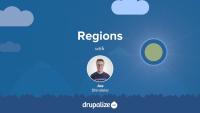Drupal comes with all of its caching features enabled by default. This improves response time, but can be frustrating for themers as it makes it harder to preview the changes you make to template files.
In this tutorial we'll look at:
- Why these features are enabled by default
- How the theme layer leverages Drupal's caches
- Why you should learn to disable them when doing development
Knowing how to inspect the variables available within a template file enables you to discover all of the dynamic content in a Twig file, not just that which is already being used.
In this tutorial, we'll learn how to use {{ dump() }}, kint(), vardumper(), and XDebug to inspect variables in a template file.
Before visitors to your site will see the pages displayed using a theme the theme needs to be installed and set as the default. This is true whether it's a custom theme you wrote yourself, or a contributed theme you downloaded from Drupal.org. Installing themes can be done either via the user interface, or using Drush. Once a theme is installed, users of your site will see all public facing page rendered using that theme. Themes that are no longer being used can safely be uninstalled.
In this tutorial we'll:
- Demonstrate how to install a theme and make it the default using both the UI and Drush.
- Learn to differentiate between installed themes, default themes, and uninstalled themes.
- Configure our site to use an administration theme for the administrative pages.
By the end of this tutorial you should be able to install a theme and make it the one visitors to your site see by default.
JavaScript is used and loaded in special ways within a Drupal site. JavaScript is loaded via asset libraries and Drupal core provides a bunch of different JavaScript libraries that you can load and use in your module or theme. This tutorial provides a brief orientation to some of the JavaScript included in core.
In this tutorial we'll:
- Preview the JavaScript ecosystem in Drupal
- Find pointers to tutorials where you can learn more about adding JavaScript to a theme or module
- Learn about examples of JavaScript in Drupal core that are useful to review for learning purposes
By the end of this tutorial you should have a good overview of how JavaScript is used throughout Drupal core.
Many of the variables that you have access to inside of a Twig template file are arrays. For example a list of values for a multi-value field, or a set of error messages generated when validating a form submission. In order to work with arrays in Twig you'll need to understand how for loops work. This is essential information for anyone creating Drupal themes.
In this tutorial we'll cover:
- Using the
fortag to iterate over an array - Using the
loopvariable inside of aforloop for additional context
Any text that will be displayed to user as part of your application's user interface should be passed through the t() function, or an equivalent, so that it can be translated into other languages as needed. This tutorial will look at how to use the t() function.
This tutorial contains information that applies to anyone writing modules or themes. And many of the tutorials you read on this site and on the web in general will expect that you understand how basic string translation works.
In this tutorial we'll look at:
- Passing strings through the
t()function or equivalent so they are available for translation - Using placeholders for dynamic content in translatable strings
- Tips for making your code's interface strings easier to translate
In order to ensure that all user interface strings in your application can be translated using Drupal's localization system, any text you add to templates needs to use either the t filter or the {% trans %} tag. Anyone creating themes or editing template files associated with a theme or a module should know how to use these two utilities.
In this tutorial we'll look at:
- How to use the
tfilter and{% trans %}tag in a Twig template - The differences between the two, and how to determine which one to use
- How to translate strings assigned to variables in preprocess functions using the PHP
t()function
In developing the theme for your website it's important to take accessibility into account. Making your site available and functional for as many users as possible is always a good idea. Progressive enhancement and graceful degradation are key, but how do you go about accounting for the minute differences between browser capabilities? This is where the Modernizr.js library can help you out.
Modernizr is a collection of browser detection tests which allow you, in either CSS or JavaScript, to determine if a particular browser supports a large list of features. From there it can automatically add classes to your page depending on the results of a particular feature test. It can also be used to create additional custom tests. In this tutorial we'll take a look at a few of the feature detection tests that Modernizr natively supports as well as how a custom test can be added to a Drupal theme.
This tutorial demonstrates how to locate the template file that is currently being used to render an element and override it in your own theme. This is an important skill for anyone who wants to make changes to Drupal's default HTML markup.
In this tutorial we'll:
- Override the node.html.twig template in our theme
- Make changes to the markup
- Create a content-type-specific template override like node--CONTENT_TYPE.html.twig
By the end of this tutorial you should be able to modify the HTML markup used to display a node, or any other element of the page generated using a template file.
The ability to loop over an array of values in a Twig template and print out each value individually is an important skill for anyone developing themes for Drupal. Common scenarios include: loop over the values of a multiple value field; iterate through a list of links; and display error messages at the top of forms. This tutorial will provide an example of using the Twig for function to iterate over a list, or a subset of a list.
In this tutorial we'll cover how to:
- Output values from a multi-value field in an unordered list.
- Add first and last classes to the first and last items in a list by using the Twig
loopvariable.
By the end of this tutorial you should be able to print out the values of an array as individual list items using a loop in Twig.
Themes define the regions that are available for site administrators to place blocks in, creating a layout framework within which the components that compose a page can be placed. As a theme developer you'll need to determine what regions are necessary to accommodate your design's layout, while also ensuring it'll work with the way Drupal uses blocks to place content onto the page. Deciding what regions to create requires knowledge of how Drupal works and a clear vision of the design you're trying to achieve.
In this tutorial we'll:
- Explain what regions are and how they relate to themes
- Describe how regions are handled internally within Drupal
- Demonstrate things to keep in mind when planning the regions for your custom theme
By the end of this tutorial you should be able to describe what a region is, explain how Drupal themes use regions to place content, and get started dissecting your own designs into regions.
The Responsive Image module provides a process for transforming images uploaded through image fields into responsive images. This is accomplished through the configuration of responsive image styles. The configuration form for adding and editing responsive image styles is quite extensive. In this tutorial, we'll go through this form and learn what each option entails. By the end of this lesson, you should have a good understanding of the various options in the responsive image style configuration form.
You might already be familiar with image styles in Drupal. Image styles are a popular and commonly used feature of Drupal because they enable your site's content creators to upload an image once, but have it displayed at various sizes and resolutions depending on its context. Image styles are configured and then applied to an image field's display settings, whether using view modes, Views field settings, or other contexts. Responsive image style field formatters are applied in the same exact way, but the process of creating responsive image styles is a bit different.
Using responsive image styles as image field formatters enables your Drupal site to produce specific HTML markup for images so that either:
- The browser can choose an appropriately sized image source, given the size of the user device's viewport size
- You can dictate to the browser which image sources to use at different breakpoints.
In the first case, the resulting markup uses the srcset and sizes attribute in an <img> element. In the second case, <picture> and <source> elements are generated in conjunction with the <img> tag.
It is also possible to create a responsive image style that just provides alternate images depending on the display-density (i.e. 1.5x or 2x) of the user device.
In this tutorial, we'll look at three use cases for responsive images, how those use cases are handled in HTML, and how they can be handled using Drupal's Responsive Image module. By the end of this tutorial, you should be ready to create a responsive image style appropriate for your Drupal site.
In this tutorial, we're going to add a responsive image style to an image field on the Article content type. This will add the srcset and sizes attributes to the output <img> element, providing media conditions, width descriptors, and a set of image sources for the browser to choose from, depending on the user device's viewport size.
This solution, especially when used in conjunction with CSS, will provide flexible, fluid, and faster-loading images for your site, and will work for probably 80% of use cases. It does not provide "art direction", that is, making cropping, aspect ratio, or orientation changes to an image. This solution also provides for different display-densities, like 1.5x and 2x image sources without the need for display-density descriptors.
Another benefit of this solution is that it uses the Responsive Image module's breakpoint configuration file, so there is no need for you to create a breakpoint file in your theme to implement this flavor of responsive image style.
Before you can create a path or link to another page on your site, you'll need to know the route (unless there is already a variable available for the URL you need). Finding a route can be a tricky task unless you have the right tools. In this tutorial, we'll show how tools like Webprofiler, Drush, and Grep can be used to get route information for a page, so that you can use functions that need a route as a function parameter.
In this tutorial we'll:
- Learn how to determine the route or path of an internal page.
It's often useful to pass dynamically calculated values from the server to the client in order to make them available to your front-end JavaScript. Your JavaScript might need to know something particular about the user currently visiting the site or the value of a particular configuration variable. In this tutorial, we'll look at how Drupal can pass these values from the PHP code that executes during a page load to the front-end JavaScript in your theme.
In order to do this, we'll need to:
- Explain how drupalSettings bridges the gap between PHP and JavaScript
- Generate values for settings in PHP and make them available to JavaScript
- Make use of PHP generated settings within your JavaScript code
You may know that Drupal provides utility PHP functions for manipulating and sanitizing strings. Drupal also provides JavaScript functions for the same purpose. The two most useful are Drupal.checkPlain and Drupal.formatPlural. Drupal.checkPlain lets you ensure a string is safe for output into the DOM; it is useful when working with user-provided input. Drupal.formatPlural ensures that a string containing a count of items is pluralized correctly. This tutorial will show you where you can find documentation for and example use-cases of both.
Each theme is a collection of files that define a presentation layer for Drupal. While only a THEMENAME.info.yml file is required, most themes will contain other files as well. Some are Drupal-specific, and need to follow a strict naming convention and be placed in the appropriate place for Drupal to find them. Others are standard front-end web assets like CSS, JavaScript, and image files that can be placed anywhere within the theme's code.
In this tutorial we'll learn about:
- The various types of files you can expect to find in a theme directory
- Where in the Drupal code base your theme directory should live
- Keeping the directory and all the files within organized
By the end of this tutorial you should be able to explain where a Drupal theme should be placed in a project's code base, and the types of files one can expect to find in a theme.
Custom themes in Drupal must be configured to inherit settings, templates, and other assets from a parent theme. Which base theme you use is configurable. This allows theme developers to use a different set of markup as the starting point for their theme, organize various theme assets into a more maintainable structure, and more. All of this is made possible because of how Drupal's theme layer uses a chain of inheritance when assembling all the parts of a theme.
Base themes are also a powerful way to encapsulate standards and best practices into a reusable code base. You'll find dozens of contributed base themes on Drupal.org that can serve as a great starting point, especially if you're planning to work with an existing design framework like Bootstrap or Susy Grids. Or if you want to leverage modern JavaScript bundling without setting up Webpack on your own.
In this tutorial we'll:
- Learn what base themes and subthemes are
- Look at a few examples of template inheritance and how that works
- Discuss some use cases for theme inheritance
By the end of this tutorial you'll know how to declare the base theme that your theme builds upon.
One important aspect of theme administration is the configuration of global and theme-specific settings. In this tutorial, you will learn where theme settings are configured in Drupal's administrative interface, the difference between global and theme-specific settings, and what each global setting refers to on a base installation of Drupal with a custom theme installed.








